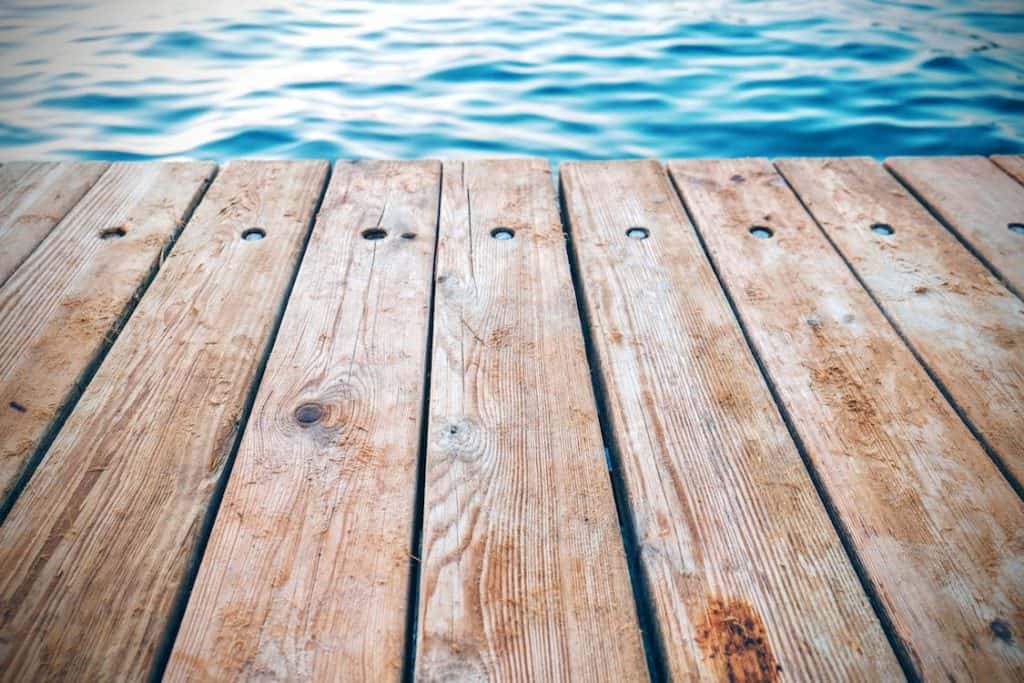Are you looking to build a deck for your next DIY home improvement project, but not sure which is the best material for a deck? With so many options available, it can be challenging to determine the best materials for your deck-building needs. At Capitol City Lumber, our Raleigh-based decking lumber supply company, we understand that selecting the right decking material is crucial to ensure the longevity, safety, and aesthetics of your deck.
That’s why we’ve created this guide to the most popular decking materials on the market. From treated lumber to composite and PVC decks, we’ll cover the pros and cons of each material, and with our assistance, we hope to give you a better idea of which decking material is right for you and your home.

Factors to Consider When Choosing a Decking Material
If you are taking on the DIY home improvement project of building a new deck, choosing the right decking material is the most crucial decision you’ll make. There are several factors to consider when selecting the best material for a deck. Let’s explore the most important factors to consider prior to committing to one decking material over another.
Climate and Weather Conditions
The climate and weather conditions of your area should play a significant role in your decking material selection. If you live in an area with high humidity, rain, or snow, you may want to choose a decking material that is resistant to rot and decay, such as Fiberon Composite decking with a 50-year warranty*, or Deckorators Eovations decking with a 25/50-year warranty*. If you live in a hot climate, you may want to choose a material that doesn’t retain heat, such as Accoya decking or Cedar decking.
Due to the high humidity and rainfall in North Carolina, it is important to choose a decking material that is resistant to rot and decay, such as KDAT treated lumber, PVC or composite decking. Additionally, the heat in North Carolina during the summer months can make some decking materials uncomfortable to walk on. Therefore, lighter-colored decking materials, such as composite or PVC decking, are a good choice for those who live in hot regions of North Carolina.
Purpose of the Deck
The purpose of your deck will also influence your decking material choice. If you plan to use your deck for hosting large gatherings, you may want to choose a material that is durable and can withstand heavy traffic. If you’re building a deck for relaxation and quiet activities, you may prioritize a material that is comfortable to walk on and doesn’t get too hot in the sun.
Budget
Budget is a significant factor in selecting a decking material. Treated lumber is the most affordable option, while exotic hardwoods like Ipe are the most expensive. Composite and PVC decking fall somewhere in the middle. You should select a decking material that fits your budget and offers the durability and features you desire.
Aesthetics
The appearance of your deck is also an essential factor to consider. If you want a natural wood look, you may choose Accoya or Cedar decking. If you prefer a uniform color and finish, composite or PVC decking may be a better choice. You should select a decking material that matches your personal aesthetic preferences and complements the look of your home.
Maintenance Requirements
For wood decking, Cedar and Treated lumber requires regular maintenance, while Ipe and Accoya can be left alone to fade to a beautiful weathered gray and give you many years of enjoyment. Composite and PVC decking also requires minimal upkeep. You should choose a decking material that fits your maintenance schedule and doesn’t require more maintenance than you’re willing to provide.
Wood Decking Options
Wood decking is a classic and timeless option for adding a natural and warm feel to your outdoor living space. With many different types of wooden decking available, it can be challenging to determine which one is right for your needs. Whether you are building a new deck or upgrading an existing one, understanding the different wood decking options available can help you make an informed decision.
Treated Lumber Decking
Kiln-dried treated decking is a popular decking material that has been chemically treated to resist rot, decay, and insect damage. Kiln-dried treated decking, also known as KDAT, has been kiln-dried to reduce moisture content below 19%, making it less likely to warp or twist. It is recommended to stain KDAT treated decking immediately after installation. The most common types of treated lumber are Southern Yellow Pine and Hem-Fir. These woods are readily available, affordable, and can be found in a range of grades and dimensions.
Pros and Cons of Using Treated Lumber for Decking
Pros:
- Affordable
- Widely available
- Resistant to rot, decay, and insect damage
- Can be painted or stained
- Easy to work with
Cons:
- Can crack, warp, or twist if not properly maintained or stained and sealed upon installation
- Chemical treatment can be harmful to the environment
- Quality can vary based on the supplier and treatment process
- Regular maintenance is required
Cedar Decking
Western Red Cedar is a popular wood species used for building decks. It is known for its natural beauty, durability, and resistance to rot and insects. Cedar wood is a softwood that is naturally resistant to rot and insects due to the presence of natural oils and tannins. It has a distinctive reddish-brown color and a straight grain that gives it a unique appearance. Cedar has a straight grain and tends to not twist as much as yellow pine treated lumber. Although Cedar is naturally resistant to rot and decay, putting an exterior grade stain and sealer on the decking will provide a longer life to your deck.
Pros and Cons of Using Cedar Decking
Pros:
- Natural beauty
- Durable and long-lasting
- Resistant to rot and insects
- Easy to work with
- Low maintenance
Cons:
- Expensive compared to treated lumber
- Can be prone to splitting and cracking
- Color can fade over time
- Softer than Treated lumber, not suitable for heavy traffic areas
Accoya Decking
Accoya is a modified wood product made from sustainably sourced softwoods that have undergone a non-toxic acetylation process. The process changes the wood’s chemical structure, making it more durable and resistant to rot, decay, and insects. It has a consistent, light color that can be stained or painted. Accoya does not visibly warp, twist or crack like Treated or Cedar. Accoya has a 25 year warranty* for decking.
Pros and Cons of Using Accoya Decking
Pros:
- Highly durable and long-lasting
- Resistant to rot, decay, and insects
- Stable and less prone to warping or twisting
- Low maintenance
- Less likely to splinter than other woods
- Barefoot friendly, stays cooler to the touch
- Sustainable and eco-friendly
Cons:
- Expensive compared to other wood decking materials
- Limited availability
- May require specialized installation techniques
Ipe Decking
Ipe, also known as Brazilian walnut, is a hardwood that is native to South America. It is an extremely dense wood with a rich, dark brown color that can range from chocolate brown to olive green. Ipe wood is resistance to rot, insects, and decay. Also known as Iron wood, Ipe is known for it’s strength and durability.
Pros and Cons of Using Ipe Decking
Pros:
- Extremely durable and long-lasting
- Resistant to rot, decay, and insects
- Low maintenance
- Natural beauty and unique appearance
- Can last up to 50 years
Cons:
- Expensive compared to other wood decking materials
- Difficult to work with due to its hardness
- May require specialized installation techniques
- Dark colors can make it hot to walk on in direct sunlight
Composite and PVC Decks
Composite and PVC decks are man-made decking materials that are designed to look like real wood but offer improved durability and low maintenance. Composite decking is made from a combination of wood fibers and recycled plastic materials. PVC decking, on the other hand, is made entirely from plastic. Both materials are designed to look and feel like real wood but offer better durability and low maintenance. Most Composite and PVC decking materials on the market have a 25 to 50 year warranty*.
Pros and Cons of Using Composite Wood and PVC Decking Materials
Pros:
- Low maintenance
- Resistant to rot, insects, and decay
- Available in a variety of colors and finishes
- Durable and long-lasting
- Eco-friendly (in the case of composite decking)
Cons:
- Expensive compared to traditional wood decking materials
- Darker colors can get hot in direct sunlight
- Some types can be slippery when wet
- Some lines are more susceptible to scratching and fading
Capitol City Lumber is Your Source of Treated Wood, Composite, and PVC Decking in Raleigh
Choosing the right decking material is a crucial decision that requires careful consideration of several factors. KDAT Treated lumber, cedar, Accoya, ipe, composite, and PVC decking all have unique advantages and disadvantages that make them suitable for different climates, budgets, uses, and aesthetic preferences.
At Capitol City Lumber, we offer a wide range of high-quality lumber decking options for all your decking needs, as well as lumber delivery. Our expert team can help you choose the right decking material that fits your needs and preferences.
Contact us today by calling 919-832-6492 or filling out our contact form below to get started on your next decking project!
* Based on Guidelines of Manufacturers Warranty.


